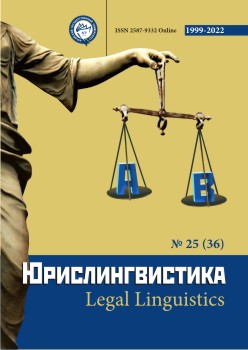Public Danger and Expediency in Relation to Criminalization of Acts with Signs of Administrative Prejudice: Analysis of Theory and Law Enforcement
Abstract
Designed to normatively distinguish crime from non-crime, criminal legislation has regained administrative prejudice to the current criminal law. The number of relevant norms in the Special part of the Criminal Law has been increasing, which keeps up the interest of scientific community for this institution. Notably, both the substance of norms with administrative prejudice and incidental problems of legal and technical order become topics for discussion. Without exaggeration, one of the most complicated problems is finding the grounds for criminalization of certain acts, since the researcher faces the need to explain the mechanism triggering the quality of public danger in an act similar to the previously committed, but lacking this quality. Generally speaking, there objectively exist qualities that allow us distinguish criminal behavior from non-criminal. The analysis of the sources permits identifying two points of view that have developed among the supporters of administrative prejudice in the criminal law, both views associate the emergence of public danger with a cumulative effect, which manifests itself either in the cumulative harm of widespread acts, or in the personal qualities of the liable person, prone to illegal behavior.Besides, we propose the idea of criminalization of certain acts with signs of administrative prejudice for reasons of expediency, in support of which we provide data on the law enforcement activities of the courts. Analysis of judicial practice and official statistics allows us to conclude that at the level of practical activity, the relationship between public danger and expediency as grounds for criminalization of the acts in question and the effectiveness of the norm is clearly manifested: the norms that appeared for reasons of expediency belong to the "dead". As for the assessment of the public danger of the acts discussed, the courts do not always share the approach of the legislator, although in general there is actually a differentiation of administrative and criminal responsibility.
Downloads
Metrics
References
Васильевский А.В., Кругликов Л.Л. Дифференциация ответственности в уголовном праве. СПб., 2003.
Головко Л.В. Разграничение административной и уголовной ответственности по российскому праву / Lex Russica. - 2016. - Т. 25. - № 1. - С. 139-145.
Есаков Г.А. От административных правонарушений к уголовным проступкам, или о существовании уголовного права в «широком» смысле / Библиотека криминалиста. Научный журнал. - 2013. - № 1 (6). - С. 37-45.
Иванчин А. О пользе разумного использования административной преюдиции в уголовном праве / Уголовное право. - 2017. - № 4. - С. 50-53.
Козаченко Я.И., Сергеев Д.Н. Новая криминализация: философско-юридический путеводитель по миру преступного и непреступного. Екатеринбург, 2020.
Колосова В.И. Административная преюдиция как средство предупреждения преступлений и совершенствования уголовного законодательства / Вестник Нижегородского университета им. Н.И. Лобачевского. - 2011. - №5 (1). - С. 246-254.
Лопашенко Н.А. Административной преюдиции в уголовном праве – нет! / Вестник Академии Генеральной прокуратуры Российской Федерации. - 2011. - № 3 (23). - С. 64-71.
Маркунцов С.А. О применении уголовно-правовых запретов, сконструированных с использованием административной преюдиции / Вестник Воронежского государственного университета. Серия «Право». - 2019. - № 3. - С. 256-263.
Пикуров Н.И. Уголовное право в системе межотраслевых связей: монография / под ред. д-ра юрид. наук, проф. А. В. Наумова. Волгоград, 1998.
Послание Президента РФ Д. А. Медведева Федеральному Собранию РФ от 12 ноября 2009 г. / Российская газета. - 2009. - 13 нояб. - № 214.
Постановление Конституционного Суда РФ по делу от 10.02.2017 № 2-П «О проверке конституционности положений статьи 212.1 Уголовного кодекса Российской Федерации в связи с жалобой гражданина И.И. Дадина» / Вестник Конституционного Суда РФ. - 2017. - № 2. -С. 59–82.
Приговор Вологодского районного суда Вологодской области от 22 сентября 2020 года по делу № 1-16/2020. URL: https://sudact.ru/regular/doc/FLcaimlkNTZO/.
Приговор Шабалинского районного суда Кировской области от 29 июня 2021 года по делу №1-2/25/2021. URL: https://sudact.ru/regular/doc/XeCLAiQNl0JR/.
Сидоренко Э.Л. Административная преюдиция в уголовном праве: проблемы применения / Журнал российского права. - 2016. - № 6. - С. 125-133.
Ф. 10а «Отчет о числе осужденных по всем составам преступлений УК РФ и иных лиц, в отношении которых вынесены судебные акты по уголовным делам за 12 месяцев 2019 года». URL: http://www.cdep.ru/index.php?id=79&item=4894.
Ф. 10а «Отчет о числе осужденных по всем составам преступлений УК РФ и иных лиц, в отношении которых вынесены судебные акты по уголовным делам за 12 месяцев 2020 года». URL: http://www.cdep.ru/index.php?id=79&item=5259.
Ф. 10а «Отчет о числе осужденных по всем составам преступлений УК РФ и иных лиц, в отношении которых вынесены судебные акты по уголовным делам за 12 месяцев 2021 года». URL: http://www.cdep.ru/index.php?id=79&item=5669.
Ф. 11.2 «Отчет о характеристике преступления, его рецидива и повторности по числу осужденных по всем составам преступлений Уголовного кодекса Российской Федерации за 12 месяцев 2021 года». URL: http://www.cdep.ru/index.php?id=79&item=5669.
Ф. 10.3 «Отчет о видах наказания по наиболее тяжкому преступлению (без учета сложения) за 12 месяцев 2021 года». URL: http://www.cdep.ru/index.php?id=79&item=5669.
Фисенко Д.Ю. Проблемы правовой регламентации института административной преюдиции в действующем уголовном законодательстве / Актуальные проблемы борьбы с преступностью: вопросы теории и практики: материалы международной научной конференции. Красноярск (4-5 апреля 2019 г.) / отв. ред. Н.Н. Цуканов. Красноярск, 2019. - С. 164-167.
Copyright (c) 2022 Юлия Караваева

This work is licensed under a Creative Commons Attribution 4.0 International License.
The authors, which are published in this journal, agree to the following conditions:
1. Authors retain the copyright to the work and transfer to the journal the right of the first publication along with the work, at the same time licensing it under the terms of the Creative Commons Attribution License, which allows others to distribute this work with the obligatory indication of the authorship of this work and a link to the original publication in this journal .
2. The authors retain the right to enter into separate, additional contractual agreements for the non-exclusive distribution of the version of the work published by this journal (for example, to place it in the university depository or to publish it in a book), with reference to the original publication in this journal.
3. Authors are allowed to post their work on the Internet (for example, in a university repository or on their personal website) before and during the review process of this journal, as this may lead to a productive discussion, as well as more links to this published work (See The Effect of Open Access).











